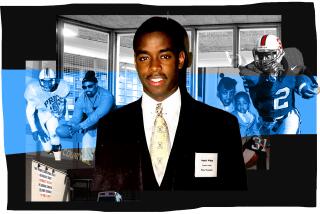In Pursuit of Justice : Johnny Boy Tried to Outrun Police, Fate; 2 Were Killed
- Share via
PHILADELPHIA — John Sullivan’s lawless young life was already careening out of control by the time the 12-year-old struck and killed two people with a stolen car while trying to outrun the cops.
“I knew sooner or later there was going to be an accident,” said Pauline Payne, the 72-year-old great-grandmother who reared the boy from infancy after his unwed parents abandoned him. “I knew he was going to do the wrong thing.”
Now, she said, “There’s nothing I can say but cry.”
John L. Sullivan III, a wisp his family called Johnny Boy, admitted responsibility for the Oct. 24 deaths of a father of nine children and an 11-year-old girl. He is serving four years at a maximum security lockup for juveniles in rural northeastern Pennsylvania.
Began With Bicycles
He was a street-savvy career criminal before age 10, when his first arrest was recorded--for stealing $327 from under his great-grandmother’s pillow. His family said he was stealing bicycles years before that.
His rap sheet includes 13 arrests, five for stealing cars, in the last two years. He escaped five times from minimum-security juvenile homes, committing more crimes every time he hit the streets.
Johnny Boy, who turned 13 on Dec. 12, was on the loose at the time of his fatal joy ride, although he was supposed to be under watch, awaiting placement in a secure state lockup that was too crowded to take him right away.
How could a boy so young get into so much trouble? Why didn’t anybody stop him?
A litany of failure offers clues: a broken home, a guardian too old to keep up with Johnny Boy, lack of resources in a social services system that should have intervened before things got out of control, and an overcrowded juvenile justice system ill-equipped for criminals so young.
“We normally don’t get kids that young in that kind of trouble,” said Mingo Stroeber, an attorney with the Defender Assn. of Philadelphia, which handled the case.
“There are very few programs equipped to deal with kids that young. Nobody seemed to know what to do with him,” she said. “These kids are victims. His family failed him. The dependent child system failed him. The juvenile court system failed him. We as a society failed.”
Others labeled him incorrigible.
“There are bad seeds. I’ve never seen one like this. He had no appreciation for Western values,” said Family Court Judge Frank Reynolds.
Johnny Boy exudes a peculiar combination of street-smart toughness and moppet charm. Prosecutors consider him a corrupt man-child who manipulates people to get his way. His lawyers thought him lovable enough to adopt.
He caused a crash that killed two people, then asked for crayons and a coloring book in jail.
He bought flowers and cards for his great-grandmother on Mother’s Day, then swiped her cash as she slept.
He could steal a car in seconds, but because he stands just 5 feet tall and weighs 100 pounds, he had to sit on umbrellas, jackets and other makeshift booster seats to help him see over the steering wheel.
Today, when most boys his age are in junior high school, John Sullivan is living behind 12-foot-high chain-link fences topped with barbed wire at the North Central Treatment Facility in Danville, Pa.
Johnny Boy’s lifetime of trouble began just months after he was born. He was given to his paternal great-grandmother by a mother who didn’t want him and a father who is a confessed murderer.
Pauline Payne raised him as best she could in the nasty North Philadelphia neighborhood.
His father, John Sullivan Jr., 32, pleaded guilty in October to third-degree murder for stabbing his girlfriend, who he said had been unfaithful. Sullivan was also charged with attempted murder in 1977 and with robbery, conspiracy and drunk driving in 1982.
No one knows what happened to his mother, Lena Daniels. She is believed dead, possibly murdered, and may have spent time in a North Carolina prison, according to fragments gleaned from 12 interviews with acquaintances and authorities. Johnny Boy, who wasn’t made available for an interview, didn’t know her at all.
“His mother was wild,” said Pauline Payne. “Neither one (mother or father) was going to take care of him.”
His great-grandmother has lived in a nursing home since May, when she broke her leg in a fall. In an interview, a reporter’s mention of Johnny Boy made her shiver.
“His legs are longer than mine, and younger too,” she said. “I couldn’t keep up with him. There are lots of things you can’t do when you get up in age. I knowed he was going to get into trouble.”
The first hint came when he was 7. Ghetto gangs appeared outside his great-grandmother’s row house at night and whistled for him to come out and romp.
“He got with the bad crowd, started stealing bikes, stealing cars and driving cars,” she said. “He wasn’t a bad little boy. He just got in with them older boys.”
She said she tried to keep Johnny Boy out of trouble and gave him love. “He’d come and look at me with them pitiful eyes and ask for a dollar. I’d give that little boy my heart. He knowed I was soft-hearted.”
But there was no one else to head off trouble.
“This kid had a poor hand dealt to him. He was not given the tools to make it,” said Gerald Stanshine, an attorney with the Defender Assn.
“He’s been on the streets more or less raising himself,” added Harvey Crudup, executive director of a juvenile detention center. “The reason it came to everybody’s attention is that he killed two people. He probably could have gone on stealing cars for years.”
First Arrest
Johnny Boy’s first arrest was July 16, 1986, for stealing $327 from his great-grandmother. She turned him in but later dropped the charges.
Before that month was out, he was arrested three times for robbery and once for arson.
Last spring, he was arrested for theft and for unauthorized use of an auto. More charges of car theft and running away followed in June.
On July 5, he was sentenced to a state lockup at Loysville and given a transfer date of Sept. 6 because no space was immediately available. Johnny Boy was placed in a juvenile home that was no match for him.
Three times he fled and was re-arrested. Each time, he was charged with theft, receiving stolen property and unauthorized use of an auto.
To hold him, authorities wanted to put him in the Youth Study Center, the city’s only maximum-security lockup for juveniles. But the 105-bed facility was 57 kids over its limit. And under a 1987 court order, the city agreed not to take anyone younger than 13.
The courts sent him back to a home that had locks on the doors and windows, but no bars.
“I couldn’t hold him because it’s against the law,” said Reynolds, the Family Court judge. “It broke my heart.”
“There were red lights flashing here. We knew if John Sullivan hit the streets, John Sullivan would commit a crime, probably with a car. We knew it, but we were powerless to hold him,” Reynolds said.
Dist. Atty. Ronald Castille derisively called the homes “escape shelters” because 40 to 50 juveniles run away from them each month. His office has asked the city for 100 additional maximum-security spaces for hard-core offenders.
“We just don’t have enough space. It’s not easy to explain to the families of the victims. You have to defend a system you know stinks,” said Al Toczydlowski, deputy district attorney in charge of the juvenile division.
Johnny Boy created his own diversion to slip out of the Juvenile Justice Center on Oct. 8. While other boys staged a fight, he stole a set of keys from a guard.
Two weeks later, he and two chums, ages 13 and 14, prowled a parking lot, looking for a car. They opted for a gray 1986 Oldsmobile Ciera, smashing a back window to get in.
Using a screwdriver with expert precision, Johnny Boy pried off the ignition lock on the steering column and hot-wired the starter.
Police spotted the joy riders running a red light and gave chase in a cruiser equipped with flashing dome lights but no siren.
With the cops on his tail, blowing their horn and flashing their high beams, Sullivan ran four stop signs and another red light.
It was 5:30 p.m. Rush hour.
“I didn’t want to get caught,” the boy told police. “I just floored it and took off. I was doing about 60 miles an hour.”
Crashes Into Chrysler
The Oldsmobile rammed a 1986 Chrysler LeBaron driven by William O’Connor, a 53-year-old real estate agent on his way home from work. O’Connor’s first wife had died of cancer in 1976, and he later married her sister. Between them, they had nine children.
The Chrysler careened into Tyesha Tate, 11, a sixth-grader walking to the grocery store with her sister, Robin, 7. They were a block from home.
Tyesha, who sang in the choir of the Second Baptist Church of Nicetown, died at a hospital. Her sister, who suffered critical head injuries, was released Dec. 5.
“The pursuit probably lasted 30 seconds,” said Officer William Rhodes, who chased Sullivan in the cruiser. “I said to my partner, ‘He’s going to crash that car.’ We were really upset when we found out other people had been hit.”
Johnny Boy suffered scratches on his arms and face. In handcuffs, he was shown the Tate girl’s body.
“He wasn’t upset. He wasn’t anything. The only thing he said was, ‘Oh, no,’ ” Rhodes said.
Some citizens criticized police for the pursuit, noting that the high-speed chase was on narrow streets through a densely populated area. But a police review of the incident classified it as proper.
Variety of Charges
Johnny Boy was charged with homicide by vehicle, involuntary manslaughter, aggravated assault, auto theft, unlawful use of an auto and conspiracy.
Because he is a juvenile, he was tried under the single charge of delinquency. In Pennsylvania, no one under 14 can be tried as an adult unless the charge is murder.
“There’s more than enough blame to spread around,” said Richard Schwartz, executive director of the Juvenile Law Center, an advocacy group.
Intervene Early
“The solution is to build another major lockup for several million dollars we don’t have or plan for a program to deal with the problem up front when juveniles first get into trouble,” Schwartz said.
“It makes more sense to spend money to build a barn that works rather than spend money on locks for a door that’s already open. You can’t do patchwork repairs on a juvenile justice system.”
More to Read
Sign up for Essential California
The most important California stories and recommendations in your inbox every morning.
You may occasionally receive promotional content from the Los Angeles Times.













